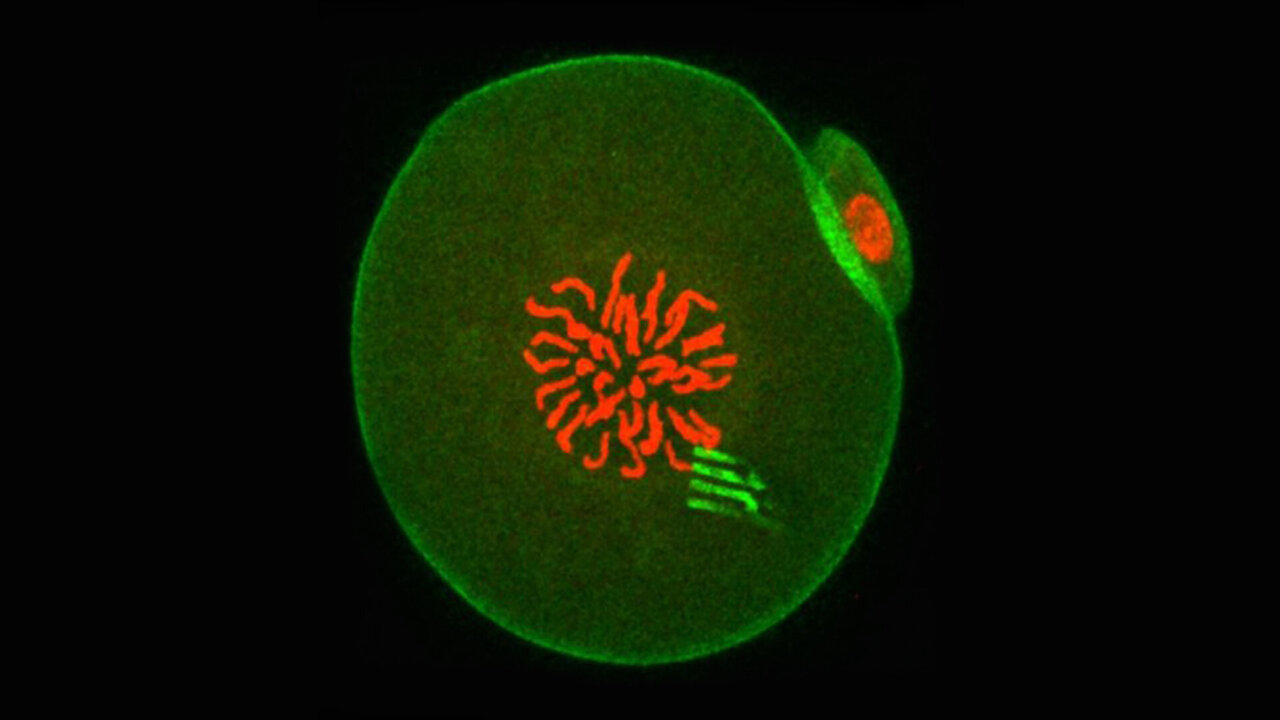Welcome to DU!
The truly grassroots left-of-center political community where regular people, not algorithms, drive the discussions and set the standards.
Join the community:
Create a free account
Support DU (and get rid of ads!):
Become a Star Member
Latest Breaking News
General Discussion
The DU Lounge
All Forums
Issue Forums
Culture Forums
Alliance Forums
Region Forums
Support Forums
Help & Search
Science
Related: About this forumNanodevices Track Cell Changes Over Time
More cool work at the interface of physics and biology. These scientists used silicon-based devices to track intracellular forces in developing mouse embryoes.

At this point in development, the embryo chromosomes (which appear red in the centre) are preparing to separate during the first cell division. The device prongs can be seen fluorescing green, with green-fluorescing actin around the periphery. Credit: Professor Tony Perry
https://phys.org/news/2020-05-nanodevices-cells-tracking.html
https://www.nature.com/articles/s41563-020-0685-9
Excerpts below:
Nanodevices show how cells change with time, by tracking from the inside
For the first time, scientists have introduced minuscule tracking devices directly into the interior of mammalian cells, giving an unprecedented peek into the processes that govern the beginning of development.
This work on one-cell embryos is set to shift our understanding of the mechanisms that underpin cellular behaviour in general, and may ultimately provide insights into what goes wrong in ageing and disease.
The research, led by Professor Tony Perry from the Department of Biology and Biochemistry at the University of Bath, involved injecting a silicon-based nanodevice together with sperm into the egg cell of a mouse. The result was a healthy, fertilised egg containing a tracking device.
The tiny devices are a little like spiders, complete with eight highly flexible 'legs'. The legs measure the 'pulling and pushing' forces exerted in the cell interior to a very high level of precision, thereby revealing the cellular forces at play and showing how intracellular matter rearranged itself over time.
The nanodevices are incredibly thin—similar to some of the cell's structural components, and measuring 22 nanometres, making them approximately 100,000 times thinner than a pound coin. This means they have the flexibility to register the movement of the cell's cytoplasm as the one-cell embryo embarks on its voyage towards becoming a two-cell embryo.
"This is the first glimpse of the physics of any cell on this scale from within," said Professor Perry. "It's the first time anyone has seen from the inside how cell material moves around and organises itself."
"From studies in biology and embryology, we know about certain molecules and cellular phenomena, and we have woven this information into a reductionist narrative of how things work, but now this narrative is changing," said Professor Perry. The narrative was written largely by biologists, who brought with them the questions and tools of biology. What was missing was physics. Physics asks about the forces driving a cell's behaviour, and provides a top-down approach to finding the answer.
"We can now look at the cell as a whole, not just the nuts and bolts that make it."
Mouse embryos were chosen for the study because of their relatively large size (they measure 100 microns, or 100-millionths of a metre, in diameter, compared to a regular cell which is only 10 microns [10-millionths of a metre] in diameter). This meant that inside each embryo, there was space for a tracking device.
The researchers made their measurements by examining video recordings taken through a microscope as the embryo developed. "Sometimes the devices were pitched and twisted by forces that were even greater than those inside muscle cells," said Professor Perry. "At other times, the devices moved very little, showing the cell interior had become calm. There was nothing random about these processes—from the moment you have a one-cell embryo, everything is done in a predictable way. The physics is programmed."
From the abstract:
The nanodevices reported reduced cytoplasmic mechanical activity during chromosome alignment and indicated that cytoplasmic stiffening occurred during embryo elongation, followed by rapid cytoplasmic softening during cytokinesis (cell division).
InfoView thread info, including edit history
TrashPut this thread in your Trash Can (My DU » Trash Can)
BookmarkAdd this thread to your Bookmarks (My DU » Bookmarks)
1 replies, 612 views
ShareGet links to this post and/or share on social media
AlertAlert this post for a rule violation
PowersThere are no powers you can use on this post
EditCannot edit other people's posts
ReplyReply to this post
EditCannot edit other people's posts
Rec (2)
ReplyReply to this post
1 replies
 = new reply since forum marked as read
Highlight:
NoneDon't highlight anything
5 newestHighlight 5 most recent replies
= new reply since forum marked as read
Highlight:
NoneDon't highlight anything
5 newestHighlight 5 most recent replies
Nanodevices Track Cell Changes Over Time (Original Post)
CatLady78
Jul 2020
OP
GreenPartyVoter
(72,378 posts)1. Makes me think of
